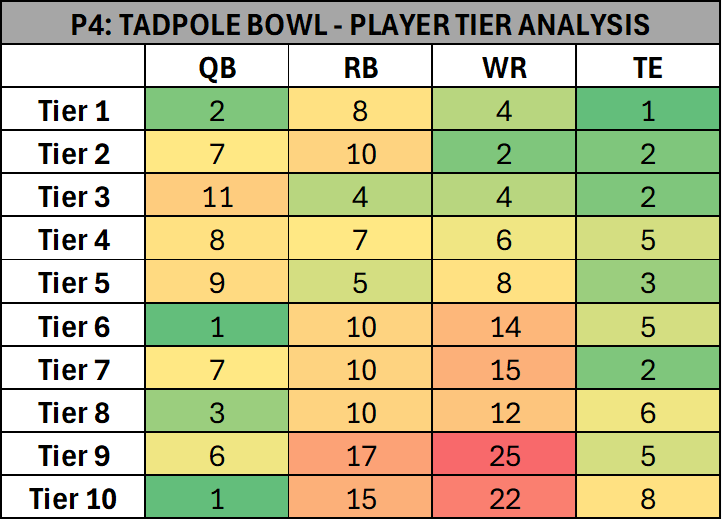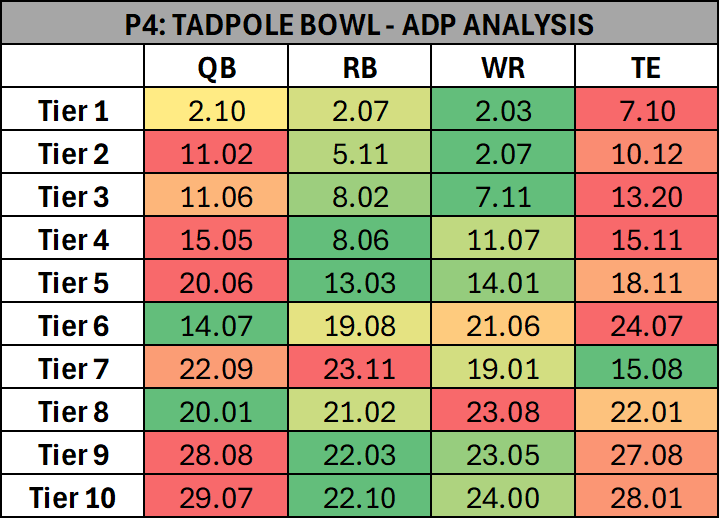Purple Reign must start by pointing out there is no “one way” to approach drafting a CFF team. This guide represents the strategy I have come up with after reviewing the 2025 player pool. You can follow this guide to the letter, or incorporate ideas into the draft strategy you already use. It is purely up to the reader how to use this information.
TIER ANALYSIS
I assign players into tiers based on several pieces of criteria. I start with the fantasy point projection I have made for the player within the specific scoring format. I then review the player’s position battle status and move players down the more uncertain that position battle status is. Then finally I review the profile I have assigned for that player. Players are moved down again based on the level of fantasy production potential.
Tiers go from 1 being the best, then counting their way downward. I consider all players from a position group in the same tier can be viewed as “equal” which allows a drafter to select the player that they like best.
Once I have finished my first round of player rankings I look at how many players from each position group are in each tier. This gives you a feel for how much depth, or lack thereof you can find at different position groups. Green represents rarity while red represents abundance. I’ve only included the top 10 tiers in this breakdown. This information will also help you determine which positions to focus on or wait for during the draft.
Quarterback: There’s a large abundance of QBs in tiers 2-3 that allows you to pass on one of the tier 1 QBs. Since the big drop off doesn’t occur until tier 6, you have the ability to spread out your bench players in tiers 4-5. You’ll want to try to tie up your remaining QBs in tier 7, with your last QB drafted by tier 9.
Running Back: There is a good amount of players that can be obtained from tiers 1-3. Since tier 1 will be gone by the end of the first round its important to be aggressive in getting the tier 2, since tier 3 sees a significant drop off. Tiers 4-5 can be tapped into if you were being aggressive drafting players from other positions at high tiers. There’s a huge abundance of RBs starting in tier 6. You could afford to shift to drafting other positions while obtaining the occasional player from tiers 6-8. RB has the second highest amount of players in tiers 9-10, behind the WR position.
Wide Receiver: The first three tiers have less players available in this format, with only ten making the cut. These tiers need to have a priority since QB and RB have much more abundance in these same tiers. This works well since player abundance increase at the WR position the further down the tiers you go. Be aggressive early, then prioritize other positions while slowly rounding out your roster as the draft goes on.
Tight End: The first three tiers have less players available in this format, with only five making the cut. You’ll want to lock on of the tier 1-3 players early to gain an advantage over the rest of your league. If you’re drafting in the 1-3 or 10-12 positions I would not recommend waiting for someone else to start the first TE run. I would look at landing your TE2 and rounding out your bench from tiers 4-7.
ADP ANALYSIS
Its extremely important to have an understanding of when players are being taken in drafts. ADP (Average Draft Position) is the tool used to assess this. I’ve pulled the ADP data from the end of June to use for this analysis. I’ve pulled the average ADP for all players within a tier for this review. Since I have players in tiers that are over-valued and under-valued, you will see players drafted earlier and later than these average numbers. The ADP data listed in this article is the average round & draft pick, with 1.01 presenting the first pic of the first round. Green represents the earliest average draft pick for a specific tier, while red represents the latest average draft pick. This ADP is from all FBS drafts which means players will be taken earlier than shown.
Quarterback: Drafters will move quickly to secure the tier 1 QBs, but then there’s a lull after that. I suspect that Tadpole drafts will have tier 2-4 QBs drafted much earlier than this ADP data show so be prepared. After you clear round 10 you can wait until the last handful of rounds to return to the tier 5-8 QBs.
Running Back: Surprisingly the RB ADP numbers drop a bit in tiers 1-2 here. You’ll need to be focused on the tier 3-4 RBs to not miss out on this heavy RB run. Once that run completes itself you can snag a tier 5 RB then the action picks back up heavy again for the last 10 rounds of the draft.
Wide Receiver: The full PPR format will see the tier 1-2 WRs going earlier than you see in other leagues. Its got to be a top priority to land one of them before pivoting back to the position by rounds 4 or 5 when tier 3 starts going off the board. Tiers 4-5 could start as early as round 8 with a WR run. After that, the remaining tiers slide to the late stages of the draft.
Tight End: Rounds 7-10 are where you’re going to have to pony up to get one of the tier 1-2 TEs. After that you’ll see s low run on tier 3-5 TEs during the teen rounds. Tiers 7-8 will be the tiers you’ll see drafted first during the late rounds of the draft.
CONCLUSION
Roster Breakdown: QB-5, RB-9, WR-8, TE-3
Rounds 1-2: 1 RB tier 1-2, 1 WR Tier 1-2
Rounds 3-5: 1 QB tier 2-3, 1 RB tier 2-3, 1 WR tier 3-4
Rounds 6-10: 1 QB tier 2-3, 2 RB tier 2-5, 1 WR tier 3-5, 1 TE tier 2-4
Rounds 11-15: 1 QB tier 2-4, 2 RB tier 5+, 1 WR tier 4-6, 1 TE tier 2-5
Rounds 16-20: 1 QB tier 4+, 2 RB tier 6+, 2 WR tier 5+
Rounds 21-25: 1 QB, 1 RB, 2 WR, 1 TE (best available)







